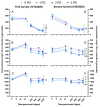Effect of Cap Management Frequency on the Phenolic, Chromatic, and Sensory Composition of Cabernet Sauvignon Wines from the Central Coast of California over Two Vintages
- PMID: 38893385
- PMCID: PMC11173441
- DOI: 10.3390/molecules29112509
Effect of Cap Management Frequency on the Phenolic, Chromatic, and Sensory Composition of Cabernet Sauvignon Wines from the Central Coast of California over Two Vintages
Abstract
Cabernet Sauvignon from the California Paso Robles AVA was processed with a contrasting array of cap management frequencies, consisting of punch-down (PD) frequencies (0, 1, 2, and 3 PD/day) over two vintages, one of which the fruit was harvested at two contrasting maturity levels. Wines followed with up to 3 years of bottle aging for basic and phenolic chemistry, and the wines of the second harvest of 2020 were submitted to sensory analysis. There were almost non-existent effects due to the frequency of punch downs on parameters such as ethanol, pH, titratable acidity, lactic acid, and glucose + fructose. In 2019, the chromatic differences between different PD regimes were subtle, and minor effects of the punch-down frequency were observed for tannins and total phenolics. During the early stages of alcoholic fermentation, higher levels of all anthocyanin classes were observed in 1 PD wines and the lowest levels in 0 PD wines. The anthocyanin content of the wines of the first harvest (unripe) was 27% higher than that of the wines of the second harvest (ripe), but these differences disappeared after 3 years of bottle aging irrespective of the vintage and harvest date. Acylated anthocyanins were preferentially lost during aging, especially in 2019 wines and, to a lesser extent, in 2020 wines. In 2020, the polymeric pigment content of the wines of the second harvest was higher than in the wines of the first harvest, with 3 PD wines showing higher polymeric pigments and yellow hues than 0 and 2 PD wines after 3 years of bottle aging. Sensory analysis of the second harvest of the 2020 wines showed that the wines of all four PD regimes were perceived as drying, signifying they were perceived as equally astringent, which is consistent with comparable tannin levels on said wines. The perception of bitterness increased with the frequency of punch downs; thus, 3 PD wines showed the highest bitterness perception. It was concluded that in sufficiently warm fermentations and small volumes, phenolic extraction occurs regardless of fruit maturity and under conditions of minimum mixing.
Keywords: Cabernet Sauvignon; cap management; phenolic compounds; sensory analysis.
Conflict of interest statement
The authors declare no conflicts of interest.
Figures










Similar articles
-
Wine Chemical Composition and Radical Scavenging Activity of Some Cabernet Franc Clones.Curr Pharm Biotechnol. 2017;18(4):343-350. doi: 10.2174/1389201018666170313100919. Curr Pharm Biotechnol. 2017. PMID: 28294060
-
Chemical, chromatic, and sensory attributes of 6 red wines produced with prefermentative cold soak.Food Chem. 2015 May 1;174:110-8. doi: 10.1016/j.foodchem.2014.10.146. Epub 2014 Nov 3. Food Chem. 2015. PMID: 25529659
-
Relationships between harvest time and wine composition in Vitis vinifera L. cv. Cabernet Sauvignon 1. Grape and wine chemistry.Food Chem. 2013 Jun 1;138(2-3):1696-705. doi: 10.1016/j.foodchem.2012.09.146. Epub 2012 Nov 10. Food Chem. 2013. PMID: 23411300
-
Multi-Year Study of the Chemical and Sensory Effects of Microwave-Assisted Extraction of Musts and Stems in Cabernet Sauvignon, Merlot and Syrah Wines from the Central Coast of California.Molecules. 2022 Feb 14;27(4):1270. doi: 10.3390/molecules27041270. Molecules. 2022. PMID: 35209059 Free PMC article.
-
Astringency, bitterness and color changes in dry red wines before and during oak barrel aging: An updated phenolic perspective review.Crit Rev Food Sci Nutr. 2019;59(12):1840-1867. doi: 10.1080/10408398.2018.1431762. Epub 2018 Feb 16. Crit Rev Food Sci Nutr. 2019. PMID: 29381384 Review.
Cited by
-
Effect of Contrasting Redox Potential Evolutions and Cap Management Techniques on the Chemical Composition of Red Wine.Molecules. 2025 Jul 29;30(15):3172. doi: 10.3390/molecules30153172. Molecules. 2025. PMID: 40807345 Free PMC article.
References
-
- Setford P.C., Jeffery D.W., Grbin P.R., Muhlack R.A. Factors Affecting Extraction and Evolution of Phenolic Compounds During Red Wine Maceration and the Role of Process Modelling. Trends Food Sci. Technol. 2017;69:106–117. doi: 10.1016/j.tifs.2017.09.005. - DOI
-
- Casassa L.F., Beaver C.W., Mireles M.S., Harbertson J.F. Effect of Extended Maceration and Ethanol Concentration on the Extraction and Evolution of Phenolics, Colour Components and Sensory Attributes of Merlot Wines. Aust. J. Grape Wine Res. 2013;19:25–39. doi: 10.1111/ajgw.12009. - DOI
MeSH terms
Substances
LinkOut - more resources
Full Text Sources
Miscellaneous

